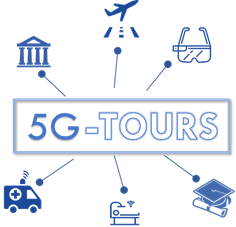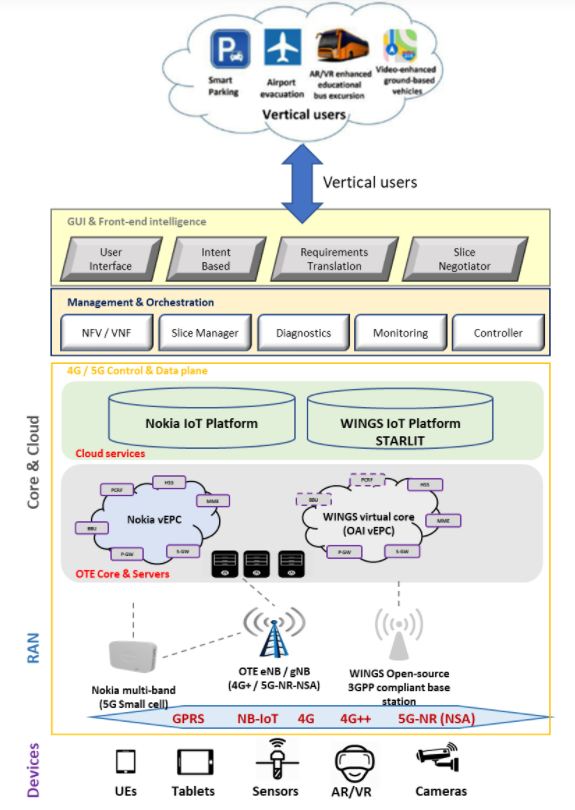Published on 28/01/2022

About the project: 5G represents a paradigm shift from a horizontal service model to a vertical one where the services provided by the network are tailored to specific industry sectors and verticals. Most of the efforts conducted so far to evaluate 5G have focused on individual vertical use cases. 5G-TOURS aims to fill this gap by demonstrating the ability of 5G to support multiple vertical use cases concurrently on the same infrastructure. 5G-TOURS will deploy full end-to-end trials to bring 5G to real users for thirteen representative use cases. The project will provide efficient and reliable close-to-commercial services for tourists, citizens and patients in three different types of cities: (i) Rennes, the safe city where e-health use cases will be demonstrated; (ii) Turin, the touristic city focused on media and broadcast use cases; and (iii) Athens, the mobility-efficient city that brings 5G to users in motion as well as to transport related service providers. These services will not only improve the quality of life for citizens and tourists, but also represent an important business opportunity as they address industry segments accounting for more than 50% of the estimated revenues generated by verticals.
The fundamental feature of the 5G-TOURS concept is the dynamic use of the network to seamlessly provide different types of services adapted to the specific needs of individual use cases. 5G-TOURS will enable different capabilities such as network slicing, virtualisation, orchestration or broadcasting as well as additional features developed by the project to bring more flexibility and improved performance. The ambition is to fully demonstrate pre-commercial 5G technologies at a large scale, showing the ability of the 5G network to meet extreme and conflicting KPIs while supporting very diverse requirements on the same infrastructure.
The 5G-TOURS mobile network system will integrate strategic components of the ecosystem, including the network infrastructure, terminals and end-devices, the vertical solutions enabled by 5G, and the vertical customers receiving the services. 5G-TOURS has devised a thorough evaluation plan to scrutinise the viability of the use cases, addressing technical performance by analysing both network service KPIs and application-level KPIs, economic impact by analysing the estimated generated revenues and, ultimately, the satisfaction of the vertical customers.
Objectives
- Network technology development: Develop a comprehensive 5G architecture that incorporates (i) the enabling technologies of the 5G-EVE ICT-17 platform, (ii) the fundamental enablers of the Phase-2 5GPPP projects 5G-MoNArch and 5G-Xcast, and (iii) novel machine learning functionalities developed within 5G-TOURS for the operation of large-scale networks; the architecture will take into account security and privacy by design requirements.
- Service layer design: Design and develop a novel service layer that provides verticals and service providers with an interface to automate their service requests, translating these requests into the corresponding network orchestration primitives in order to deploy and manage the network slice for the service provider.
- Vertical solutions development: Develop the set of vertical solutions and applications enabled by 5G technology that are needed for the envisioned use cases; this comprises, among others, media distribution applications, media production solutions, a connected robot, e-health-related products and mobility platforms. These solutions require the network services provided by 5G, which will be delivered by means of the 5G mobile terminals or chipsets provided by 5G-TOURS.
- Trials deployment: Deploy three large-scale field-trials comprising indoor and outdoor deployments and involving real end-users and vertical operational services in three different European cities: Turin, Rennes, and Athens. The deployments will be based on the existing infrastructure offered by the 5G-EVE project; in an initial phase, deployments are planned to cover localized areas while in a latter phase they will cover much larger spaces, including high density areas subsequently involving high data volumes.
- Use cases deployment: Deploy 13 use cases of interest for tourists and citizens around the themes of the touristic city, the safe city and the mobility-efficient city, and trial them in a real environment involving all the relevant players of the ecosystem and providing an operational service to the relevant vertical customer in each case.
- Network services’ KPIs: Meet the highly challenging requirements of the use cases addressed by 5G-TOURS in terms of the service provided by the network.
- Vertical services’ KPIs: Improve the quality perceived by the customers of the services addressed by 5G-TOURS use cases. Indeed, the network KPIs mentioned in Objective 6 are not a final goal by themselves, but rather a means to provide better services to customers. Hence, the ultimate objective of 5G-TOURS use cases is to deliver better services by relying on 5G technology, and thus increase customers’ satisfaction.
- Economic impact: Foster new business models around mobile networks that address new industry segments not effectively covered by 4G and provide new revenue streams, establishing a greater proportion of Business to Business (or B2B) revenue opportunity, with particular emphasis on the industry verticals. The estimated revenue increases resulting from this model are above 30%.
- European industry: Strengthen European industry by (i) reinforcing European leadership in those areas where Europe retains a strong position, (ii) improving its position in those areas that are currently dominated by other world regions, and (iii) contributing to Europe’s positioning in the new opportunities and ecosystem that will be created around 5G technology.
- Societal benefits: Deploy use cases that bring benefits to society in the areas of accessibility, culture, education, safety, sustainability, emergency care in rural areas and remote health monitoring of elderly people.
- Standardisation, IPR and industrial dissemination: Produce the necessary standards, patents and contributions to industry fora in order to (i) attract vertical industries to use 5G-TOURS technology; (ii) foster the widespread adoption of the technology beyond manufacturers and operators of the consortium; and (iii) protect the project findings to secure the commercial advantage of 5G-TOURS partners.
Use cases/verticals
The use cases addressed by 5G-TOURS revolve around the life in a city. The focus is on improving the quality of life of the citizens as well as the experience of the tourists visiting the city, ultimately making the city more attractive to visit, more efficient in terms of mobility, and safer for everybody. In 2018, more than 55% of world’s population lives in urban areas, and this number is expected to reach 68% in 2050; in Europe, these percentages are even higher; hence, improving life in the city will have a positive impact on the majority of the population. To achieve this vision of 5G-driven quality of life improvements for tourists and citizens, the use cases addressed by 5G-TOURS are grouped around three main themes that represent different aspects of the city (see Figure 1):
- The touristic city: The visitors of museums and outdoor attractions are provided with 5G-based applications to enhance their experience while visiting the city. This includes VR/AR applications to complement the physical visit with additional content, involving interactive tactile communications. The experience of the visitors is also enhanced with robot-assisted services, telepresence to allow for remote visits, as well as live events enabled by mobile communications such as multi-party concerts.
- The mobility-efficient city: Mobility to reach and move inside the city is made more efficient and comfortable. This involves smarter cities, gathering information about the city and using it to improve navigation systems as well as parking. Traveling is also made more enjoyable, providing AR/VR services to passengers, and airports become logistically more efficient by relying on 5G for their operation.
- The safe city: 5G technology greatly improves the safety in the city by providing means to better assist health-related care in all the phases of an incident, ranging from the health monitoring for prevention and early detection, to diagnosis and intervention at the ambulance, and surgery at the wireless operation room in the hospital. Also, 5G enables monitoring and remote assistance to tourists from their home country.

WINGS involvement
WINGS will be the Quality Assurance manager of the project focusing on securing quality in all activities and project reports, organize the peer review of the project documents. WINGS will also lead the “System integration and evaluation” of the 5G-Tours platform while shaping the evaluation methodology of the project and participating in the technical evaluation w.r.t to the Athens and Rennes nodes technologies. WINGS will participate in 2 use cases in the safe city (Rennes node) and in all 4 use cases in the mobility-efficient city (Athens node) acting also as the Greek node leader. WINGS will drive the functionality and technical requirements derivation of the aforementioned use cases, and assist the deployment implications when needed, while participating in the design of the overall architecture of the project. WINGS will enhance the STARLIT platform to support the health monitoring and emergency situation notification tasks, as well as the one involving the optimal navigation of the ambulance to the incident scene and the hospital. WINGS will also support all use cases of the Greek node by providing hardware and software vertical solutions tailored to the corresponding requirements: the parking occupancy sensors and a platform that will manage the sensors information to provide targeted suggestions to travellers leveraging AI algorithms; a complete AI-based optimal routing solution; and mobile development and integration.

WINGS prospects /exploitation
WINGS plans to exploit the outcomes of the project, especially the ones related to health, wellbeing and transportation, towards enhancing the company’s software solutions (such as STARLIT, a smart cities and assisted living platform but also other solutions in different vertical domains), extending the supported set of connectivity options and offering certain quality guarantees.
Awards & demonstration video
TBA
Website: http://5gtours.eu/
Framework: 5G PPP Phase 3
Duration:
![]() This project has received funding from the Horizon 2020 programme under grant agreement No 856950.
This project has received funding from the Horizon 2020 programme under grant agreement No 856950.


